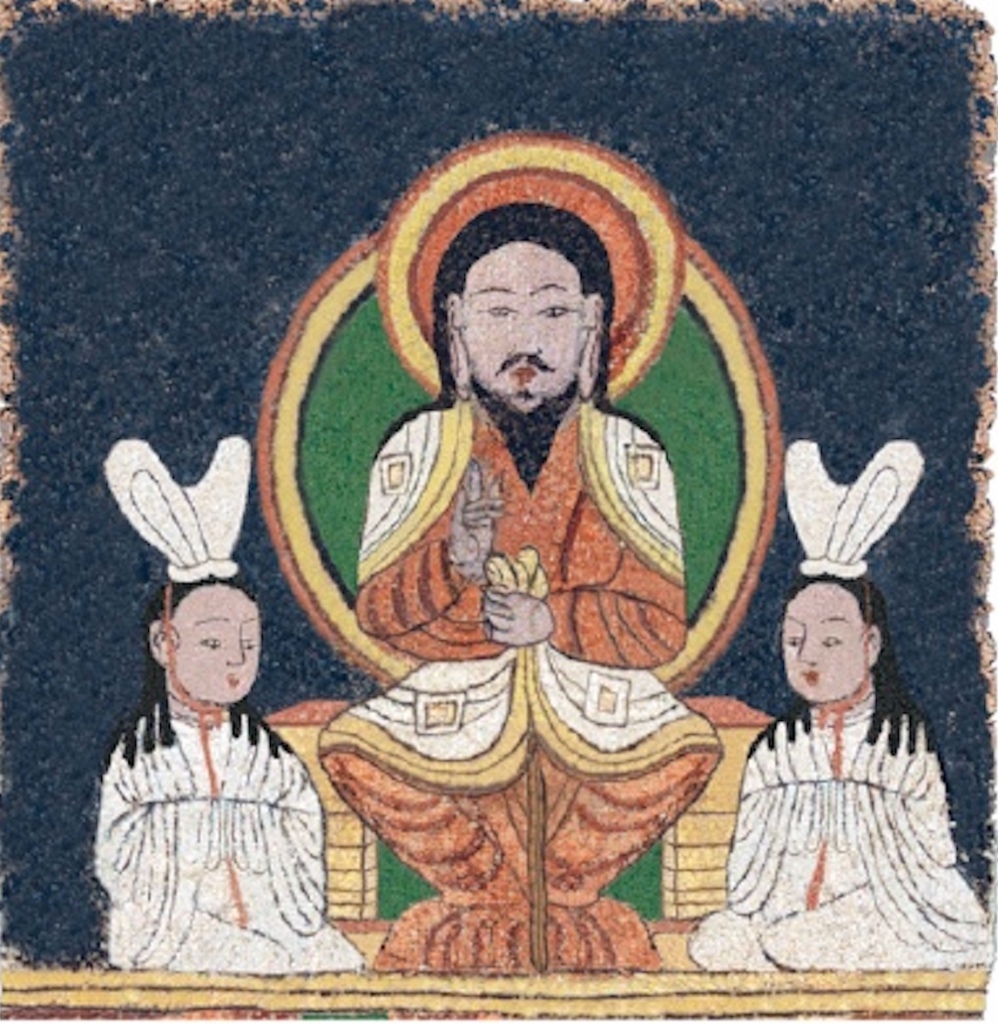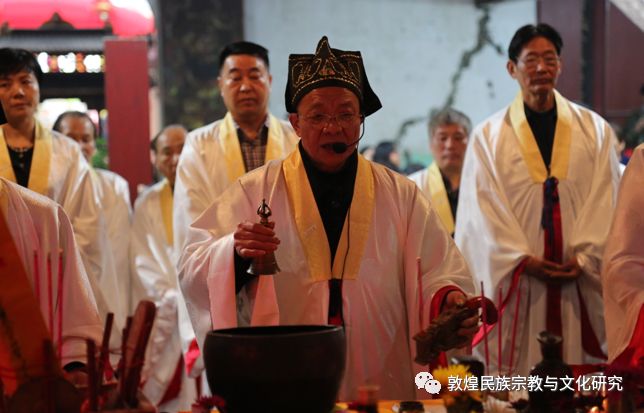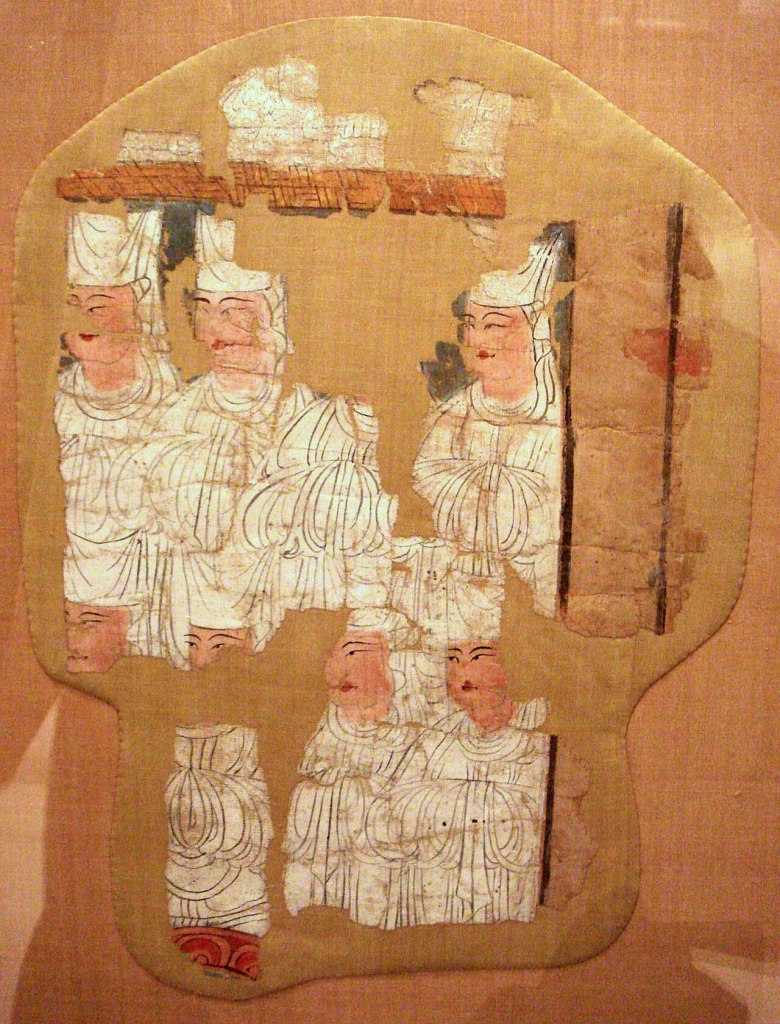Written by Afsheen Sharifzadeh, a graduate of Tufts University focusing on Iran and the Caucasus. This article surveys the Manichaean religion which was founded in Sasanian Persia in the 3rd century AD but quickly expanded into the Roman Empire and Inner Asia, with a pocket surviving in Fujian, China into modern times
The only extant statue of the Iranian prophet Māni (摩尼 Móní), carved into a cliff at the Cǎo’ān nunnery (photo 3) in 1339 A.D. by Chinese Manichaeans during the Yuan Dynasty, Jinjiang, Fujian province, China. In China, Māni assumed the configuration of “Māni, Buddha of Light,” depicted with straight hair draped over his shoulders and sporting a beard in a Chinese Manichaean icon from the 14th or 15th century A.D. (photo 2) The distinctive features of the prophet (arched eyebrows, fleshy jowls) are still apparent in the carving. By report, the statue had a mustache and sideburns, but they were removed by a 20th-century Buddhist monk trying to make the statue more like a traditional Buddha. UNESCO made the site of the Manichean Cǎo’ān a World Heritage Site in 1991 as a unique relic of an extinct world religion.
Background
Māni (216–274 CE) was an Iranian prophet born near the Sasanian Persian capital, Ctesiphon, who experienced two revelations at the ages of 12 and 24 from a spirit whom he later called his heavenly ‘Twin’ (Greek: σύζυγος súzugos “yokefellow”; Aramaic: תאומא tɑʔwmɑ “twin”). Following successive revelations by Zoroaster, Buddha, and Jesus Christ—the three ‘Apostles of Light’—Māni stylized himself as the ‘final seal’ (or παράκλητος Paráklētos ‘Paraclete of Truth’) in a line of prophets whose respective religions had come to predominate in Rome, Persia and China. Moreover, all three faiths were widespread in the heterodox milieu of Sasanian Persia, where Māni had grown up in a noble Parthian family belonging to the Jewish Christian sect of the Elkasaites in Asōristān (Sasanian Mesopotamia). In essence, Māni’s message calls upon the faithful to liberate the divine light that is imprisoned in matter so it can return to the realm of pure spirit (the World of Light); salvation is obtained through spiritual knowledge and purification from material attachments, since the physical world is inherently evil. It is believed that laypeople who are righteous and follow the Manichaean mysteries will reincarnate into plants that can possibly be saved by being eaten by the Elect (the priesthood). The prophet himself composed numerous sacred books: seven were written in Syriac—a liturgical Aramaic language understood in Asōristān—and one tome outlining the religion for King Shapur I in Middle Persian, called Šābuhragān (Chinese: 二宗经 Èrzōng jīng). Māni was also a famed painter who propagated his teachings through illuminated picture books such as the Aržang (New Persian: ارژنگ; Coptic: ⲉⲓⲕⲱⲛ Eikōn; Parthian: dō bunɣāhīg), songs of praise and theatrical performances, among other media.
Manichaeism has been called ‘the only world religion in the true sense.’ Māni envisioned a creed that covered the whole known world, embraced and surpassed all of its previous traditions, and explained all things in heaven and earth. Owing to its zealously missionary nature, within a mere two centuries Māni’s high-mythologized, universalist, dualistic, vegetarian doctrine gained adherents in viz. Hispania, Gaul, Rome, Numidia (Algeria), Egypt, Mesopotamia, Persia, Transoxiana and China, where it has endured in an altered form into modern times. It is clear that various regional iterations of the faith came into existence–e.g. the so-called ‘Chinese Manichaeism’, ‘Roman Manichaeism’, ‘Egyptian Manichaeism’–which were in early times regulated by the Holy See of Babylon based in Ctesiphon and headed by the office of the Archegos (ἀρχηγός).
Whilst the entirety of the existing Manichaean corpus was recovered fragmentarily in Egypt and China in the 20th century, this speaks naught to the popularity of the religion in other regions. Indeed, Saint Augustine of Hippo (present-day Algeria) was a Manichee prior to his conversion to Christianity following a disillusioning experience with Faustus of Mileve, another Numidian Manichaean bishop in Carthage, and the final recorded Archegos in Ctesiphon, known as Abū Hilāl al-Dayhūri (r. 754–775 AD) to the Muslims, was of North African extraction. Hilary of Poitiers wrote that Manichaeism was a significant force in Roman Gaul by 354 A.D, and numerous Manichaean monasteries existed in Rome in 312 AD during the time of Pope Miltiades. The Uyghur Khaghanate, under the influence of its urban Sogdian clients-turned-bureaucracy, even elevated Manichaeism to its official religion from 763 to 840 AD. Nonetheless, Manichaeism is the only major organized religion with worldwide following that has undergone near-total extinction as a result of severe persecution.
(1) Phases of Manichaean history (3rd-17th centuries A.D.) (2) The spread of Manichaeism (~300-500 A.D.)
Manichaean Cosmogony, Social Organization and Ethics
Māni’s essentially Gnostic doctrines describe a fantastically detailed system of divine and demonic forces. In casting aside syncretic influences and considering notions unique to Manichaeism, the following may be enumerated. The Manichaean narrative speaks of a primordial cosmological battle between two ‘realms’ or ‘natures’ existing outside the limits of the physical universe: the World of Light and the World of Darkness. The conflict between these two intangible realms composed of the substances Light (Spirit) and Darkness (Matter), respectively, continues to define all of reality. The story begins when greedy demons of Darkness attacked the World of Light, causing God (‘Father of Greatness’) to summon divine emanations of himself in defense of his realm. However, in the course of the ensuing combat, the two substances became mixed at the hands of merciless demons. Then, a second set of Light divinities were summoned, who created the world, sun, moon and stars as a complex vehicle for separating the two substances. But demons retaliated to this tactic by further dividing the imprisoned Light into the material constituents of Earth. Thus humans, animals, plants, water, soil and other features are sparks of Light trapped in the illusion of matter, causing the Light particles to become defiled by the Darkness encapsulating them. Therefore, the Manichaean view explained the existence of evil by positing a flawed creation in the formation of which God took no part, and which constituted rather the product of an attack by evil beings against God. The appearance of the Prophet Māni was another attempt by the World of Light to reveal to mankind the true source of the spiritual light imprisoned within their material bodies.
Perhaps owing to their ‘inferior’ intellect (mental activities are a manifestation of Light), animals other than humans were viewed as the abortions of she-demons and therefore were particularly rich in Dark substance. While plants—particularly melons, cucumbers, grapes and other vegetables and fruits with considerable luminescence—were believed to contain high concentrations of Light particles that could be liberated through the Elect’s digestive processes (detailed below). Thus man’s charge is twofold in lending support to the World of Light and its struggling, non-omnipotent God. First, humanity must accept the rules and regulations of the Manichaean Church such as personifying virtues of Light (Spirit), including patience, honesty, non-injury, joy, kind words, temperance, wisdom, vegetarianism and charity. Of note, there exist no commandments about gender roles or sexual orientation for either lay-followers or the priesthood, allowing a socially progressive interpretation of Māni’s teachings, not dissimilar to the tone taken by Zoroaster in the Gāthās. Second, ascetic elites, or the “Elect”, are further tasked with freeing dispersed Light from its demonic material entrapments in the form of vegetables, fruits and grains so it may return to the World of Light. The ascension takes place via the two “ships” or “storage vessels” in the sky—the sun and moon, whose waxing and waning corresponds to the transit of Light—and thence off through the Milky Way.
Artistic restoration of ‘The Work of the Religion Scene’ (MIK III 4794 recto, detail), an illuminated manuscript from Aržang, or Māni’s ‘Book of Pictures, recovered near Turfan, China. This painting is a didactic diagram explaining the goal of Manichaean practice: the freeing of the Light from the captivity of the darkness. Laypeople donate vegetarian food (that is believed to have a high concentration of Light particles) to the Elect (the priesthood). After consuming this food, the bodies of the Elect free the Light. Through the singing of hymns, light departs from the bodies of the Elect and heads towards to the World of Light. The moon and sun act as vessels of the light, transporting the freed Light particles back to God (to the World of Light). God, i.e., “the Father of Greatness” (symbolized here by his right hand) reaches into the scene from above to receive the shipment
Manichaean social organization divided the faithful into two classes: the “Elect”–or elite monks committed to itinerant missionary work and a life of monastic asceticism– and the “Hearers”–or lay-followers leading relatively ordinary lives. These had a reciprocal relationship with each other, inasmuch as the Elect needed the financial and material (food, clothing, shelter) support of the Hearers who committed vices such as procreation and crop cultivation, which were viewed as propagating matter and thereby furthering the dispersal of Light. The Hearers in turn depended on the spiritual salvation provided by the chaste, vegetarian and indigent lifestyle of the Elect, who had to scrupulously follow twelve ethical commandments in order to purify their bodies as instruments of Light liberation. The Elect, who were “sealed” with the three seals of mouth and hands and breast (ensuring virtue of speech and act and feeling), lived in monasteries, but also went on journeys on foot to spread and strengthen the faith, eating a vegetarian meal only once a day after nightfall. As neither community was completely prepared to fulfill all of its respective religious duties, regular atonement ceremonies (Parthian: xwāstwānīft “confession”) were performed on Sundays for Hearers and Mondays for the Elect. It was believed that Hearers who were righteous could possibly be reincarnated as Elect, or perhaps as fruit, which could be saved by being eaten by the Elect. The Elect’s souls, having been untangled from the darkness coating them, could return to the World of Light (Heaven) at the time of life’s departure. Jesus Christ, Māni’s forerunner and whose apostle he himself was, serves as the “guiding deity” who greets the light bodies of the righteous after their deliverance.
Icon of the King Jesus; a digital reconstruction of the enthroned Jesus (光明夷數 Guāngmíng yí shù ‘Jesus of Light’) image on a Manichaean temple banner from ca. 10th-century Gāochāng, China. It is the oldest known Manichean Jesus portrait.
Moreover, the Hearers were expected to provide alms of vegetarian food to the Elect, who would liberate the Light particles imprisoned in melons, gourds, grapes, fruit juice etc. through the miraculous purifying instrument of their digestive tracts. During the daily meal ceremony, the digestive processes of the Elect served as ‘altars’ upon which food was offered and ‘burned’, followed by sequences of prayers and songs of praise for the ascension of freed Light back to the World of Light. The alimentation rituals were elaborated during the ‘Throne festival’ (Greek bēma; Mid. Pers. and Parthian: gāhrōšn “Throne of Light”)—held on the final day of the Manichaean fasting month—when a large portrait of Māni himself (Greek eikṓn, Mid. Pers. pahikirb) would be positioned on a splendidly adorned ‘throne’ at the head of the meal ceremony.
(1) Sacrificial ceremony for the 1013 birthday of Lín Dèng (林瞪; 1003-1059 A.D.), an important Chinese Manichaean leader who lived during the Northern Song Dynasty in Băiyáng township, Xiápǔ county, Fujian province, China. Today in Băiyáng Township, the “Xiápǔ Manichaean manuscripts” are used for rituals conducted for Lín Dèng in the three villages of Băiyáng 柏洋村, Shàngwàn 上万村, and Tǎhòu 塔后村 (2) Master Chen Peisheng officiates prayer scene at Puxi Fushou Palace (福寿宫), Fuzhou, China. (3) A Yuan-era black glazed bowl found at the Cǎo’ān Temple excavation with the engraving on the bottom “Church of Light” (明教會 Míng Jiàohuì), a name for the Manichaean faith known in China as 明教 Míngjiào “Religion of Light”
Syncretism in the Cases of Egypt and China
The remarkable degree of syncretism present in Māni’s teachings allowed local beliefs to be seamlessly woven into the fabric of his own unique notions. By a process loosely analogous to molecular mimicry in venereology, contrived similarities between Manichaean teachings and native beliefs occasioned the rapid comprehension and adoption of his religion by converts. Names for Māni’s religious concepts and mythological actors were often substituted for names drawn from the local religion, while prayers, hymns, and other forms of worship were in many cases adopted wholesale with little variation. Thus Abbā dəRabbūṯā (“Father of Greatness”, the highest Manichaean deity of Light), in Middle Persian texts might either be translated literally as pīd ī wuzurgīh, or substituted with the name of the deity Zurwān, from the Zurvanist branch of Zoroastrianism. The names Māni had assigned to the gods of his religion show identification with those of the Zoroastrian pantheon, even though some divine beings he incorporates are non-Iranian. For example, Jesus, Adam or Eve were, respectively, given the names Xradesahr, Gehmurd or Murdiyānag. Similarly, the Manichaean primal figure Nāšā Qaḏmāyā “The Original Man” was rendered Ohrmazd Bay, after the Zoroastrian god Ohrmazd. Because of these familiar names, Manichaeism did not feel completely foreign to the Zoroastrians in Mesopotamia, Persia and Transoxiana.
This process continued in Manichaeism’s meeting with Chinese Buddhism, where, for example, the original Aramaic קריא qaryā (the “call” from the World of Light to those seeking rescue from the World of Darkness), becomes identified in the Chinese scriptures with Guanyin 觀音 (Avalokiteśvara; lit. “watching/perceiving sounds [of the world]), the bodhisattva of Compassion. During and after the 14th century, some Chinese Manichaeans involved themselves with the Pure Land school of Mahayana Buddhism in southern China. Those Manichaeans practiced their rituals so closely alongside the Mahayana Buddhists that over the years the two sects became indistinguishable. The Cǎo’ān temple in Fujian stands as an example this synthesis, as a statue of the “Buddha of Light” is thought to be a representation of the prophet Māni.
(1) 10th-century Manichaean Electae (women), discovered at the capital of the Uyghur Khaghanate, Gāochāng 高昌 (قۇچۇ Qocho; قاراغوجا Qara-Khoja), Turfan oasis, China (photos 2-3) The ruins of Gāochāng, designated the capital of the Uyghur Khaghanate in 850 A.D., Turfan, China
According to Chinese adherents of Manichaeism during the Ming dynasty, their religious tradition made its way into China via Mōzak during the reign of Emperor Gaozong of Tang (650–683 AD). Bishop Mihr-Ohrmazd, a disciple of Mōzak, followed his mentor into China and was granted an audience with Wu Zetian, who wielded significant power during the Tang dynasty from 684 to 690 AD and ruled as the emperor of the Wu Zhou dynasty from 690 to 705 AD. According to later Buddhist sources, during this audience, he presented the Šābuhragān (Chinese: 二宗经 Èrzōng jīng), which apparently became the most popular text among Chinese Manichaeans. In 731 AD, Emperor Xuanzong sought a summary of their foreign religious beliefs from a Manichaean, resulting in the creation of a text known as the “Compendium of the Teachings of Māni, the Awakened One of Light.” This text interprets the prophet Māni as an incarnation of Laozi.

Egypt was evangelized in Māni’s lifetime by his early disciple Adda who arrived in Alexandria, according to Manichaean narratives recovered at Turfan in China. Lower Egypt served as an early transit for the faith into the Roman Empire, from which it spread to Carthage and Western Europe. However, Upper Egypt in particular has been seen as a Manichaean stronghold. In the remote Kellis Oasis in Upper Egypt, Manichean psalms to Jesus were discovered that bear almost the exact formula of a Christian psalm, praising Jesus in every stanza, until the very final words: ‘Glory and victory to our Lord, our Light, Mani and his holy Elect’ (Psalmbook 52). This inherent flexibility likely facilitated its widespread acceptance across various milieus by permitting the harmonization of its teachings with pre-existing religious beliefs. On many occasions, Manichaeans were confused for by the remarkable ability to camouflage at a moment’s notice. Paradoxically, however, this malleability may have contributed to the eventual evaporation of Manichaeism, akin to sand slipping through fingers, as adherents may have found it effortless to revert to the majority religion when the need for spiritual conformity arose. In times of persecution, layers of Manichaean-specific doctrines could be relinquished without the necessity of renouncing the majority faith in its entirety.

The ruins of Kellis, Egypt. The oases of Upper Egypt once served as a stronghold of Manichaeism, with much of the the current Manichaean corpus being recovered from 20th-century expeditions there
















Pingback: An Etymology of the Sogdian Title “Afšīn” – borderlessblogger